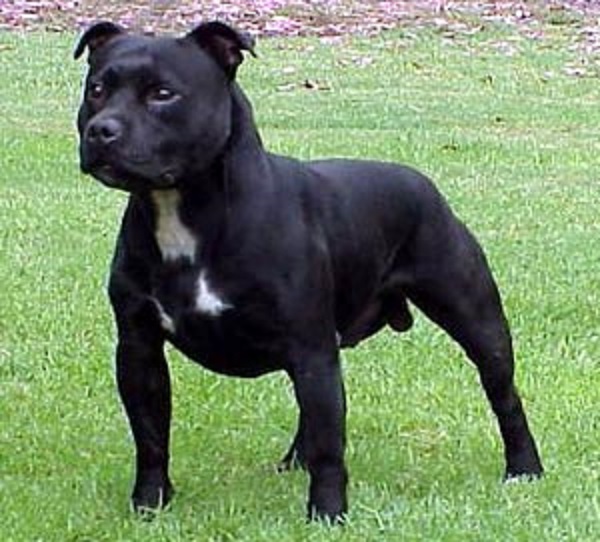
Staffordshire Bull Terrier

Navigate through the tabs
Navigate through the tabs below to view the breed's info of your interest.
The breed's info is divided in four sections; namely:
the breed's history ,
the breed's main stats ,
the dog's potential health issues
and finally, how the breed scored in 26 different categories.
All the above information should give you a respectively good overview for the dog of your interest.
Dog Breed's Main Info
The Breed's History:
Before the 19th century, bloodsports such as bull baiting, bear baiting and cock fighting were common. Bulls brought to market were set upon by dogs as a way of tenderizing the meat and providing entertainment for the spectators; and dog fights with bears, bulls and other animals were often organised as entertainment for both royalty and commoners.
Early Bull and Terriers were not bred to resemble the companion animals of today, but for the characteristic known as gameness, with the pitting of dogs against bear or bull and exotic animals testing this attribute along with the strength and skill of the dog. Landrace working dogs crossbred with bulldogs provided the ancestral foundation stock for the Staffordshire Bull Terrier, the Bull Terrier, the American Pit Bull Terrier and American Staffordshire Terrier. This ancestor is traditionally known as a "Bull Terrier", believed to be around 200 years old by the time of the early 21st century, and is rather a class of races than a particular breed.
These bloodsports were officially eliminated in 1835 as Britain began to introduce animal welfare laws. Since dogfights were cheaper to organise and far easier to conceal from the law than bull or bear baits, bloodsport proponents turned to pitting their dogs against each other instead. Dog fighting was used as both a bloodsport (often involving gambling) and a way to continue to test the quality of their stock. For decades afterward, dog fighting clandestinely took place in pockets of Britain and America. Dogs were released into a pit, and the last dog still fighting (or occasionally, the last dog surviving) was recognised as the winner.
The quality of pluckiness or "gameness" was still highly prized, and dogs that gave up during a fight were reviled as "curs". Despite being trained to be aggressive towards fellow dogs, they had to be of good temperament with people as the handler would have to bring the dog back to scratch for each round.
As time went on the modern breed has become one with a temperament suitable for a pet and companion. It gained respectability, becoming a dog worthy to show, and was accepted by The Kennel Club of the United Kingdom as the Staffordshire bull terrier in 1935.
Country of Origin:
England
Breed Group:
Terrier
Height:
1 foot, 2 inch. to 1 foot, 4 inch. (35,56 to 40,64 cm)
Weight:
24 to 38 pounds (10,88 to 17,24 Kg)
Life Span:
12 to 14 years
Potential Health Issues:
Elbow Dysplasia,
Canine Hip Dysplasia (CHD),
Patellar Luxation,
Hereditary Juvenile Cataracts,
L-2 Hydroxyglutaric Aciduria,
Skin Allergies,
Demodectic Mange
Adaptability
Apartment Living:
First Time Owners:
Sensitivity:
Being Alone:
Cold Weather:
Hot Weather:
Friendliness
Affection With Family:
With Kids:
With Dogs:
With Strangers:
Health and Grooming
Shedding:
Drooling:
Easy To Groom:
Overall Health:
Weight Gain Potential:
Size:
Training
Easiness:
Intelligence:
Mouthiness:
Prey Drive:
Barking or Howling:
Wanderlust:
Need For Exercise
Energy Level:
Intensity:
Exercise Needs:
Playfulness:
Our Mobile Application
Check out Our Mobile Application "Dog Breeds Central"
